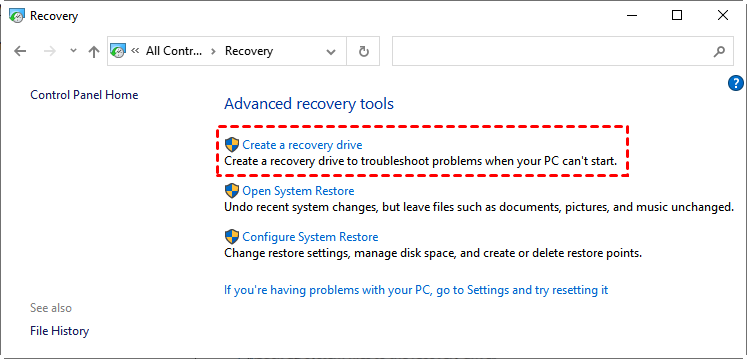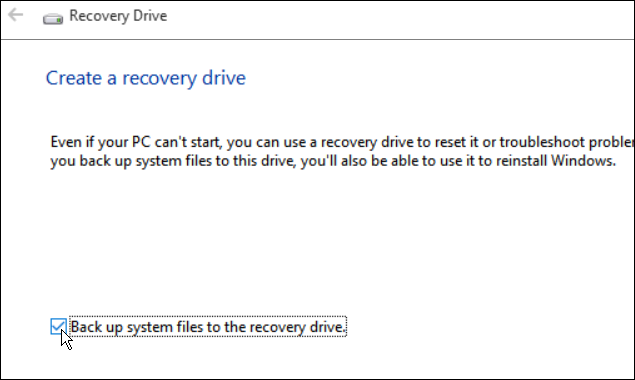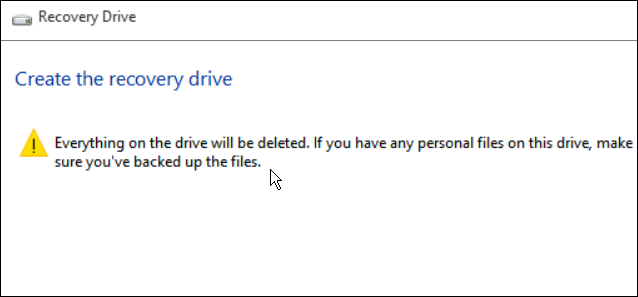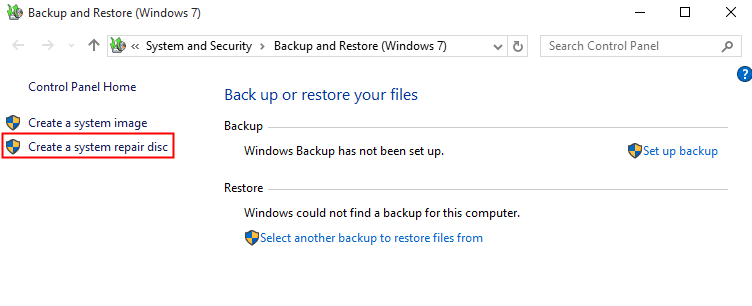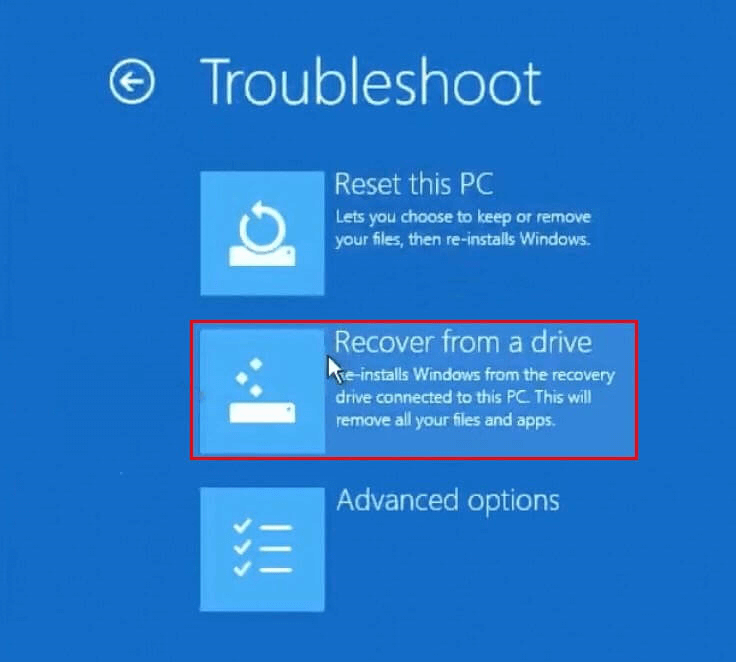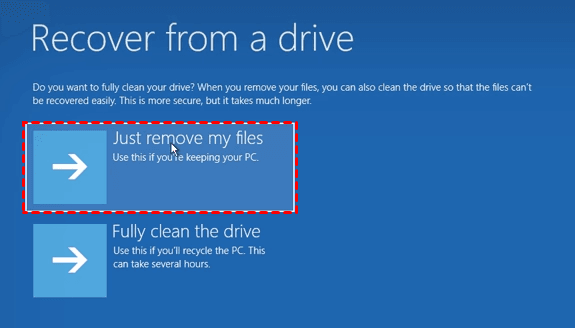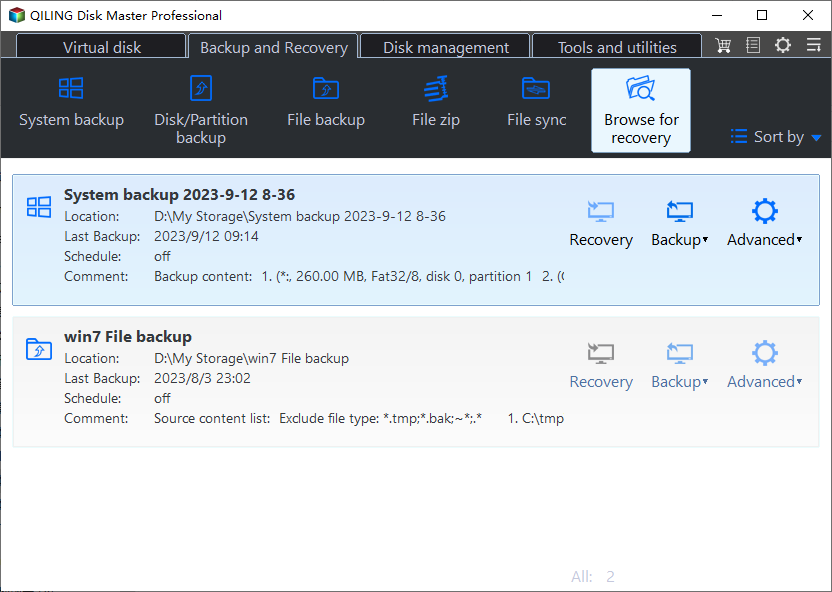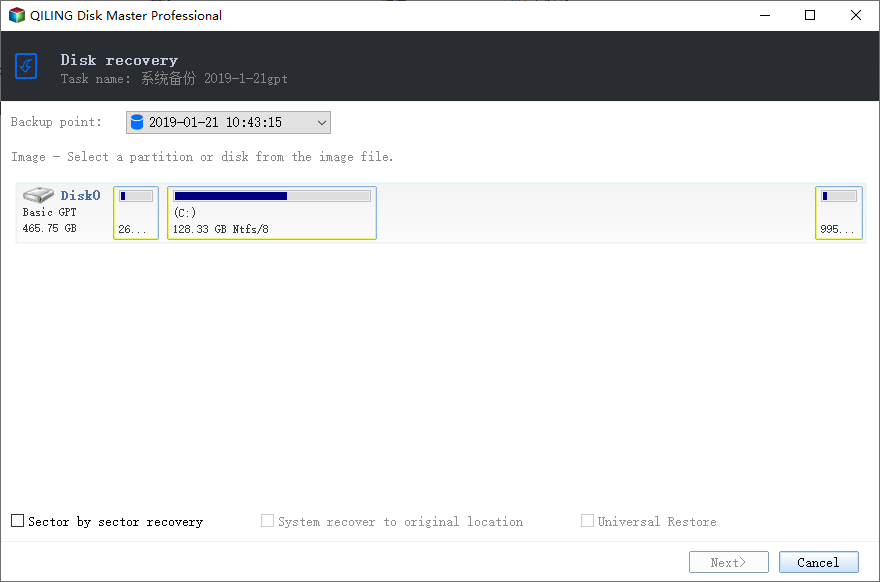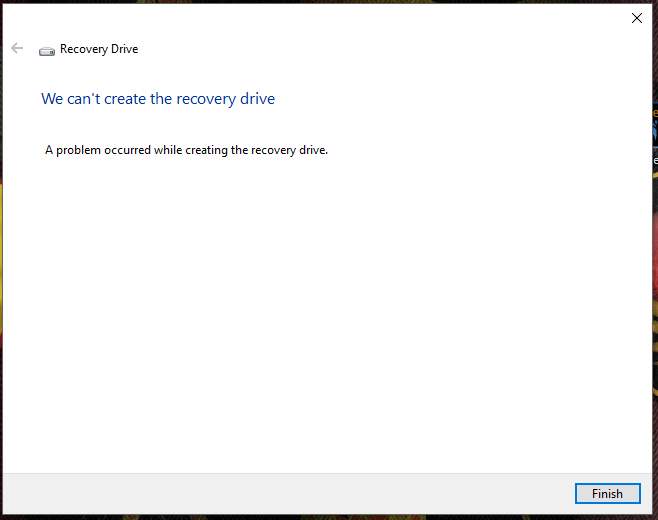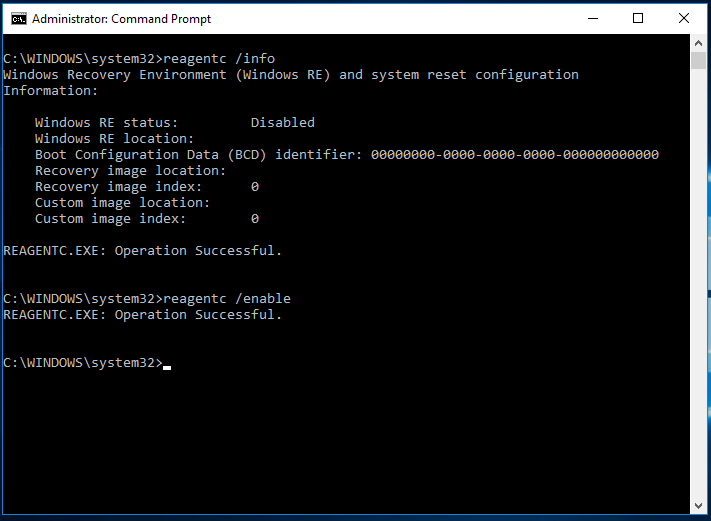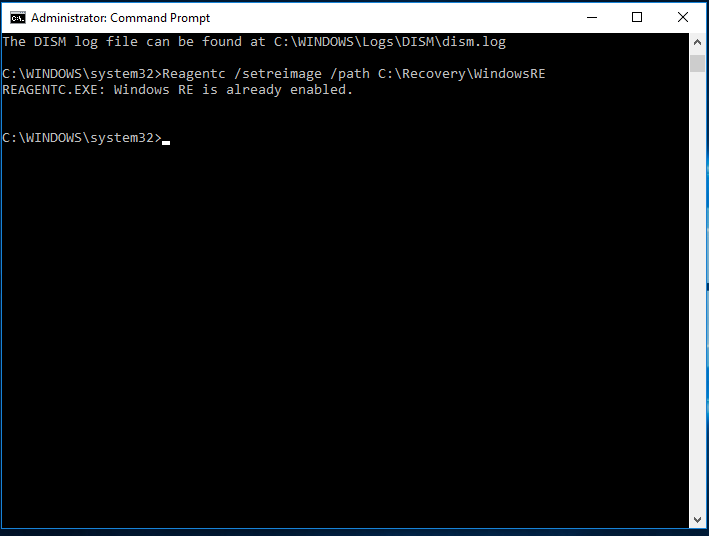3 Free Ways to Create Windows 10, 11 Recovery Disk or USB
- What is a Windows recovery disk or USB
- Which kind of recovery disk should you choose?
- How to create Windows 10/11 recovery drive (3 free ways)
- Way 1. Create Windows 10/11 recovery USB with Recovery Media Creator
- Way 2: Create system repair disc in Windows 10/11 using Backup and Restore
- Way 3. Create Windows 10/11 boot repair drive via Qiling Disk Master
- How to restore Windows 10/11 using different recovery drives
- #1: How to restore Windows from recovery USB or repair disc
- #2: How to restore operating system via Qiling bootable drive
- Troubleshoot: A problem occurred while creating the recovery drive
- Solution 1. Check the USB drive
- Solution 2. Enable Windows recovery environment
- Solution 3. Create Windows recovery environment with installation ISO file
- Solution 4. Fix to failed to include system files
- FAQs about Windows 10 recovery disk
- Conclusion
🌟 Video Guide: How to Create a Windows 10 Recovery USB
(*This video only offers 2 ways. To learn more ways, please read below.)
What is a Windows recovery disk or USB
In literal terms, a Windows recovery disk is a bootable disc containing advanced recovery options, such as System Restore, Startup Repair, Safe Mode and Command Prompt, with which you can fix system errors and even reinstall Windows 10 or other OS from startup.
But since Windows 8, Windows has added a new feature to create Windows recovery USB. It is becoming a more mainstream approach in Windows 10/11 due to the portability. So nowadays, the "recovery disk" in the broad sense usually includes bootable USB as well. Of course, if you do not have any USB drive or simply do not want it, you can still use CD or DVD to create a system repair disc.
Quick Navigation:
👉 Which kind of recovery disk should you choose?
👉 How to create Windows 10/11 recovery drive (3 free ways)
👉 How to restore Windows 10/11 using different recovery drives
👉 Troubleshoot: A problem occurred while creating the recovery drive
👉 FAQs about Windows 10 recovery disk
Which kind of recovery disk should you choose?
Both recovery drive and repair disc can help you access recovery options even when you fail to boot Windows 10/11. But there are some differences between them:
| Types | Device | Functionality | Compatibility |
| Recovery drive | Requires a USB drive | Recovery drive mainly helps you reset PC or troubleshoot problems. It also allows you to backup system files for Windows reinstallation. | A recovery drive is tied to the current PC. To make a Windows recovery USB that can be used on another PC, please try this way. |
| Repair disk | Requires CD/DVD | Repair disc is used to boot your computer. It also contains Windows system recovery tools to help you fix Windows or perform a system image recovery. | A repair disc can be used on different computers with the same version of Windows. |
✍Make the choice based on your needs, such as whether you want to use USB or CD/DVD, whether you need to reinstall Windows, whether you need to use it on a different computer...and whichever you choose, it's best to recreate one every year because Windows updates will improve security and PC performance periodically.
Related Tips:
- Besides recovery media, it's also recommended to backup Windows 10 regularly in case of unexpected data loss. A recovery drive isn't a system image, and cannot ensure your personal files, settings, apps, etc.
- There's another commonly used bootable drive, namely installation media. It's mainly used to clean install or reinstall Windows 10/11 and can also be seen as a last resort to resolve severe system failures. Details can be found in Windows 10 recovery tools.
How to create Windows 10/11 recovery drive (3 free ways)
There are 3 methods to create Windows 10 or 11 recovery drive for your reference.
| 💻Way 1. Recovery Media Creator |
Create Windows 10/11 recovery USB with Recovery Media Creator >>Details It is designed to create a recovery USB tied to the current PC. |
| 💿Way 2. Backup and Restore |
Create system repair disc in Windows 10/11 using Backup and Restore >>Details It is used to create a repair CD/DVD. |
| 🔰Way 3. Qiling Disk Master |
Create Windows 10/11 boot repair drive via Qiling Disk Master >>Details It works with both USB and CD/DVD. The drive made with Way 3 can be used to boot different computers running different systems, and even non-system computers. |
Way 1. Create Windows 10/11 recovery USB with Recovery Media Creator
Some users may wonder if it is necessary to format the USB in order to make recovery drive. The answer is no, because the Recovery Drive will create a FAT32 formatted USB that can boot in both BIOS-based and UEFI-based PCs.
As for the USB capacity issue, since the process will copy a lot of files to it, you need to prepare a flash drive that has at least 16 GB capacity, and ensure it's empty, because all the data on the USB drive will be deleted. Follow the step-by-step guide below.
1. Connect the USB drive to your computer and get access to the recovery drive. You may be asked if you want to allow this app to make changes to your device, please click "Yes". Here are two ways you can use:
>> Type "recovery drive" into the search box and select "Create a recovery drive".
>> Go to "Control Panel", select "View by smaller icons" and "Recovery", then choose "Create a recovery drive" in the advanced recovery tools page.
2. In the pop-out window, check the option "Back up system files to the recovery drive" and hit "Next".
Note: The option "Back up system files to the recovery drive" will create a recovery drive that allows you to reinstall Windows.
3. Then select the USB flash drive you prepared, and click "Next" to continue.
4. On the next screen, you will be told everything on the drive will be deleted, so please make sure there is no important data. Then, click "Create" to begin creating Windows 10 recovery USB drive.
After finishing this process, you will see an option "Delete the recovery partition from your PC" if you have a Windows recovery partition in Windows 10/11 computer. You can click it to delete recovery partition to free up some space on your computer.
*You may find the Windows bootable USB is not working in some cases. For example, you cannot use a Windows 8 recovery disk to restore Windows 10, nor can you use a recovery drive made by Windows 10 64-bit to boot a 32-bit computer. That is to say, you cannot use a Windows 10 recovery USB created in this way on another computer.
Way 2: Create system repair disc in Windows 10/11 using Backup and Restore
As mentioned earlier, you can create a Windows 10 repair disk using CD/DVD, and it can also be done with Windows built-in utility.
1. Type " backup settings" in the search box and select it. Then, scroll down to "Looking for an older backup" and click "Go to Backup and Restore(Windows 7)".
2. Click "Create a system repair disc" at the left panel of Backup and Restore (Windows 7) page.
3. Then, you will be asked to select a CD/DVD drive and insert a blank disc into the drive, please do as instructed.
4. Click "Create disc" to create Windows 10/11 recovery disk with CD/DVD. Then, it will start to write this disc, this process only takes a few minutes.
Way 3. Create Windows 10/11 boot repair drive via Qiling Disk Master
As mentioned, the repair USB created by the recovery media creator will not work on computers running different systems (or non-system computers). If you want a more flexible way, you can choose to use a third-party media creator - Qiling Disk Master Standard.
With it, you can not only create Windows 10/11 recovery USB for the current computer but also another PC, and it can be applied to all Windows PCs, including Windows 11/10/8/7 (both 32 bit and 64 bit). With it, you can enjoy the following advantages:
✭ It enables you to create bootable DVD/CD or USB that can be used to start a crashed computer of HP, Lenovo, Acer, ASUS, Dell, etc. And the created media is able to boot in both BIOS and UEFI mode.
✭ You can also create a Windows 10 recovery disk from another computer to boot the problematic one if your system crashes before you made a recovery drive.
✭ As a complete data protection solution, it allows you to create scheduled system backup, disk backup, file backup and partition backup to various locations, such as local disk, external drive or network share, cloud, etc.
How to create Windows 10 recovery USB with Qiling Disk Master:
1. Download the Windows 10/11 recovery USB media creator - Qiling Disk Master, install and launch it.
2. To recover Windows via this tool, you can create a regular system backup in "Backup" tab. Then click "Tools" from the left panel and then select "Create Bootable Media".
3. Then you can select a "CD/DVD" or "USB drive" to create this Windows 10/11 bootable recovery media and then click "Proceed" to run this process.
Note: If you don't have CD/DVD or USB, you can choose to export Windows 10 recovery ISO image file.
With the help of Qiling Disk Master, you could create Windows 10 recovery USB to boot the current computer or another PC into WinPE, and then perform system restore from a created system image.
Advanced Features You May Need (Available in Professional edition):
✭ If you haven't made any system backup before the failure, you can also create system image on another working computer, and restore it to the problematic one via the Universal Restore feature.
✭ If you don't have any CD/DVD or USB drive, you can simply enable the Qiling recovery environment to achieve the same effect as recovery disk.
How to restore Windows 10/11 using different recovery drives
After creating Windows 10/11 recovery USB, you may want to know how to use it. Then, I'll show you two common ways, namely, using Windows recovery drive or repair disc, and the third party rescue disk.
#1: How to restore Windows from recovery USB or repair disc
1. Insert your recovery drive or system repair disc. Then, press the displayed F key on the initial screen when you start computer, then change the recovery drive or disc as the first boot option in the BIOS and boot from it.
2. Then, it will start to the Windows recovery environment, select keyboard layout and hit "Enter".
3. In the blue Troubleshoot page, you will see "Reset this PC", "Recovery from a drive" and "Advanced options".
Both of the previous two options are to reinstall Windows, but the first one allows you to choose to keep or remove your files. The third option is to repair your computer using recovery tools, such as system restore, system image recovery, startup repair, command prompt, etc.
4. Take "Recover from a drive" as an example, click it. Then, select "Just remove my files" to delete only files on your computer. If you want to fully recycle this operating system, you can choose "Fully clean the drive".
5. Click "Recover" to start the recovery process. It will take a while to finish and your PC will restart. Please follow the on-screen instructions to configure your preference settings.
#2: How to restore operating system via Qiling bootable drive
1. Connect the backup drive containing the system image and recovery disk to your computer. Then, boot your computer with the disk created by Qiling Disk Master.
2. Once the file loading process completes, you will see the main page of Qiling Disk Master Standard. You can click "Restore" and "Select Image File" to find the system image created ahead of time.
3. Select "Restore this system image" and tick "Restore system to other location" if necessary, then click "Next".
4. (Optional) To restore system to a different location, select a destination disk to store the backup image and click "Next". If the destination disk is a new one, please connect it in advance.
5. If you are restoring system to an SSD, tick "SSD Alignment" to accelerate the writing and reading speed of SSD disk. Then, click "Proceed" to restore system image using recovery disk.
Relate tip:
If you need to restore system image from another computer with different hardware, the steps are almost the same, but remember to tick "Universal Restore" (available in Professional edition). It will ensure the computer can boot after restoration.
Troubleshoot: A problem occurred while creating the recovery drive
Sometimes, users may find that they are not allowed to create recovery disk in Windows 10/11 and the built-in tool says, "We can't create the recovery drive. A problem occurred while creating the recovery drive". Don't worry, and get corresponding solutions below.
Solution 1. Check the USB drive
If Windows failed to create a recovery drive with an error "We can't create the recovery drive", you should first check whether your USB drive is well connected and can be recognized by Windows. If that is not the case, you can simply download the Windows 10/11 recovery disk ISO file and burn it to your USB flash drive or CD/DVD. If you do not want to download an unofficial file, then you can try following solutions.
Solution 2. Enable Windows recovery environment
Another likely cause of this problem is that Windows recovery environment is disabled. You can run command "reagentc /info" in an elevated Command Prompt to check it. If the Windows RE is disabled, you can type "reagentc /enable" to reenable it. After that, you should be able to boot into recovery environment. If this also fails, you can turn to Solution 3.
Solution 3. Create Windows recovery environment with installation ISO file
1. Create a folder named WindowsRE under the Recovery folder of C: drive. The Recovery folder is hidden by default. To show it, you can:
- Search "show hidden files" from the search box and select the top result.
- In the pop-up window, click "Show settings" next to "Change settings to show hidden and system files" to open File Explorer Options.
- From there, check the option Show hidden files, folders, and drives, and uncheck the option Hide protected operating system files (Recommended).
Tip: If you still don't see the Recovery folder, you can create one under the root directory of C: drive.
2. From this step to Step 4, you will create a Winre.wim file. If you have that file backed up or you can copy it from another Windows 10/11 computer, you can just skip to Step 5. If you do not have one, you can download installation ISO file from Microsoft. Then, double-click to mount it as a virtual drive.
3. In the Source folder, locate the file Install.wim. Copy the Install.wim file's location path.
4. In an elevated Command Prompt, use the following syntax:
dism /mount-wim /wimfile:[the install.wim file path you just copied] /index:2 /mountdir:[a location path to save the mounted file]
In my case, it is:
dism /mount-wim /wimfile:"F:\windows 10 ISO\sources\install.wim" /index:2 /mountdir:D:\mount_image_file\
5. From the location you entered at the end of the above command, find the Winre.wim file and copy it to "C:\Recovery\WindowsRE".
6. Then type command Reagentc /setreimage /path C:\Recovery\WindowsRE and press Enter. After that, you should be able to create a recovery drive in Windows 10/11 successfully.
Solution 4. Fix to failed to include system files
If you can create a Windows 10/11 repair USB drive without including system files, but fail to create it when you check the option "Back up system files to the recovery drive", then you can try the following.
1. Copy the install.wim file from the Windows 10/11 installation file to a folder on your hard drive. Say it "D:\Windows-OS-image".
2. Open an elevated Command Prompt, type Reagentc /setosimage /path D:\Windows-OS-image /index 1 and press Enter.
After that, you should be able to include the system files on the recovery drive, so you can use the recovery drive to ret Windows 10/11 without requiring anything on your hard drive.
FAQs about Windows 10 recovery disk
Windows Recovery Disk is a storage device that contains Windows exact copy and troubleshooting tools for you to fix system problems and reinstall Windows to restore system back to normal.
First, plug your CD/DVD or USB flash drive into your Windows 10. Second, input the recovery drive in Windows 10 search box, select Create a recovery drive. Then, ensure the Back up system files to the recovery drive option is checked, and hit Next. Choose the device you connected and press Next. Finally, tap Create to create a Windows 10 repair disk.
It's hassle. Because the two computers have to be the same make, model, even the drivers, and the devices installed. The free backup software for Windows - Qiling Disk Master Standard provides the easiest way to create recovery drive from one computer and use it on another no matter what the Windows OS is.
First of all, please check if the media is connected well. If still not working, try to fully format the USB drive/CD/DVD. Or repair the recovery environment first, and enable it. The ultimate way is to create Windows recovery drive with the installation ISO file.
If your computer crashes before you create a recovery drive, you can reset Windows 10 to factory settings with the "Reset this PC" feature. Or you can create a Windows 10 recovery disk from another computer.
Conclusion
That's all for how to create Windows 10/11 recovery disk. If you prefer to create Windows recovery disk for another computer, or one works on any version of Windows system, it is highly recommended to use Qiling Disk Master to create one for them all instead of creating one by one (like Windows 10 repair disk for Windows 10, and another Windows 11 recovery disk for Windows 11). Whenever your system fails to boot, Qiling Disk Master can help you restore system from the recovery disk with no effort.
If you want to protect unlimited computers within your company, you can pick Qiling Disk Master Technician Plus. With the inbuilt Qiling Image Deploy tool, you are also allowed to deploy/restore system image file on server-side computer to multiple client-side computers over network.
Related Articles
- Restore Windows 10 from Recovery USB (4 Ways included)
Now is the best time to create a recovery disk and then you can restore Windows 10/11 from USB when your computer runs into issue. 4 useful methods and complete guides are included. - Best Ways of HP Recovery Media Creation in Windows 10
It's necessary for us to create HP recovery media in Windows 10 for disaster restore. Then, how to create it easily? Find best ways in this article. - Can I Use Recimg Windows 10 to Create a Custom Recovery Image
Is Recimg in Windows 10 available? Learn to create a custom recovery image in Windows 10 that is used to reset this PC like the way you did with Recimg in Windows 8. - Restore Windows 10/11 System Image to New Hard Drive | 2 Ways
You will learn how to easily restore Windows 10/11 system image to new hard drive with Backup and Restore (Windows 7) or powerful backup software- Qiling Disk Master Standard.
